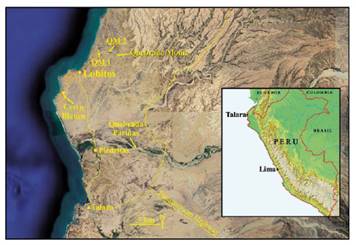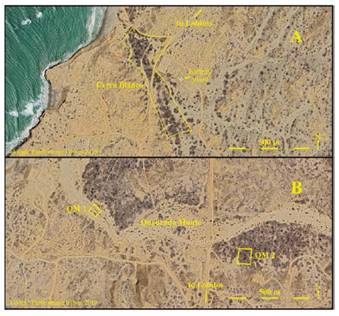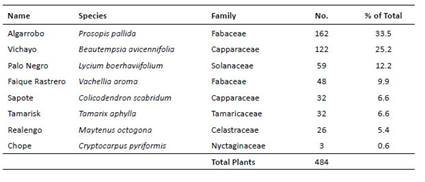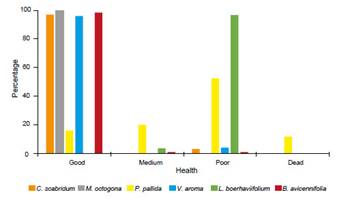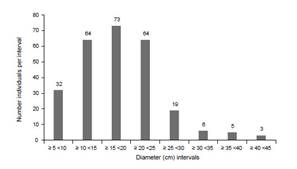Introduction
The Peruvian Plantcutter has been classified as a threatened species for the last 30 years or so, originally by Collar & Andrew in 1988 (see BirdLife International 2020). A specialized herbivore, it is restricted in range to the coastal lowlands of northern Peru, from sea level to 550 m (Collar et al. 1992), although Pollack et al. (2016) registered it at 670 m. Nevertheless, from Flanagan et al. (2009) the majority of 53 records throughout its distribution were below 200 m. Within this range the species inhabits open dry forest, desert scrub, riparian thickets and low open woodland (Collar et al. 1992), though the critical precondition for its sustained presence at a site is the availability of certain native flora for its diet (e.g. Abramonte 2007, Liñan Flores 2013, Rivas 2015, Romo & Rosina 2012 and Rosina & Romo 2012). Two important plant species are Prosopis pallida (Algarrobo) and Lycium boerhaviifolium (Palo Negro or Canutillo). P. pallida is of great importance as a keystone species, a nitrogen fixer and, in general, it is the most common species in this habitat type. It is also a principal food source for the Plantcutter. L. boerhaviifolium is less common and generally absent from many areas on the north coast although, as first noted by Rosina and Romo (2012), it appears to be particularly important in the diet of the Plantcutter and may represent a driving factor in the bird’s distribution.
Although it is accepted that the species is threatened by habitat loss and degradation (BirdLife International 2020), little or no work has been done to quantify this process. Studies have been conducted into the floristic diversity of the sites and diet of the Plantcutter (for example: Abramonte 2007, Liñan Flores 2013, Rivas 2015, Romo & Rosina 2012, Rosina & Romo 2012 and Romo et al. 2015), which have helped understand the species´ ecological requirements. Deforestation and degradation mainly appear in two forms: the outright clearing of habitat for small-scale and large agro-export agriculture, and for urban expansion; and the selective logging of P. pallida for timber, firewood or conversion to charcoal for restaurants - an illegal activity that affects most of the coastal dry forests of northern Peru and which authorities are unable to control. Although longer-term studies are required, the loss of P. pallida appears to affect the stability of sites with other species later dying off, particularly L. boerhaviifolium (pers. ob.).
Another critical factor for the survival of the Plantcutter, its habitat and dry forests in general along the coast is the widespread dieback of P. pallida. Although the exact causes and processes involved have not been fully elucidated, and detailed publications are anticipated, some sources point to the impact of the gall midge Enallodiplosis discordis (Diptera: Cecidomyiidae: Cecidomyiidinae) (Whaley et al. 2010, Gagné & Whaley 2020). The gall midge was "originally associated with leaflets of Prosopis tamarugo in Chile" (Gagné & Whaley 2020). This author´s reference search suggests it was apparently first reported in Peru prior to 2010 in Ica by Whaley (2010), where it had infected and impacted Prosopis limensis ´Huarango´. The Global Biodiversity Information Facility only cites the midge as being distributed in Chile (GBIF 2020), but it is now found on Prosopis spp. all along the Peruvian coast. And as there appear to be no historical records of the species in Peru, the hypothesis that other factors such as prolonged drought or climate change have facilitated its spread from the south is a possibility. Whatever the exact causes of the dieback, its impact is clearly visible and probably started more than 15 years ago. In the Santuario Histórico Bosque de Pómac, a state protected area of 5,880 ha in Lambayeque Region and a Plantcutter site, a 2019 biodiversity monitoring programme using thirty 30 x 30 m quadrats recorded a 40% mortality of the P. pallida (J. Ayasta Varona pers. comm.). Around Talara Province the author has found dry gullies and areas with 80-90% mortality and advanced infestation.
Clearly this unprecedented situation requires more research, but perhaps more importantly urgent actions are needed now in advance of fully understanding the causes of the dieback. In March 2020, the Peruvian government established an inter-ministerial working group to investigate the dieback (Resolución Ministerial Nº 0080-2020-MINAGRI) and the Ministry of Environment is leading the preparation of a Global Environmental Facility (GEF) proposal (H. Gutiérrez pers. comm.).
The objective of this article is to present the initial and extremely worrying results of the first phase of a longer-term monitoring and reforestation programme in Talara Province, Piura Region, based on the conservation of the Peruvian Plantcutter (Phytotoma raimondii).
Material and methods
Study site.The main study site was Cerro Blanco (also known as Yapato), a shallow dry gully, some 2 km to the south-west of Lobitos. The area was first visited in October 2017 by the author after first reviewing potential sites for the occurrence of Peruvian Plantcutter in Google Earth (i.e. looking for small patches of denser vegetation in otherwise barren landscapes around Lobitos). The site proved to be important for the Plantcutter with an estimated 8 individuals in the area and has been visited several times ever since. However, by January 2018 loggers had entered the area and cut out 40 to 50 reasonably sized P. pallida; the dominant species in the habitat here. Selective logging of P. pallida was already occurring at the site as verified by older and weathered P. pallida stumps, cut by axe. Moreover, it is evident that loggers returned, even as recently as early 2020, to cut ever smaller P. pallida. However, no site monitoring to gauge habitat and P. pallida loss, the dieback and secondary impacts has been implemented to date. As a first step towards justifying the need to protect Cerro Blanco, the author, assisted by EcoSwell, conducted a baseline survey of flora and degradation. This would also serve to refine inventory methods for later studies. Given the severity of degradation found at Cerro Blanco, the author decided to include two smaller comparative plots to help clarify the extent of degradation in the region and show that the status of Cerro Blanco was not an anomaly. These plots were in Quebrada Monte c. 2.5 km north-east of Lobitos, where 90 ha are held under a preliminary land-title (´posesión´) by Lobitos residents, who aim to restore and conserve the native vegetation. The Plantcutter has been previously recorded in this area by the author and others.
At Cerro Blanco (UTM 17M 467200 m E, 9505400 m S, altitude 0 to 20 m), an area of 10 ha was surveyed (Figs. 1 and 2). The limits of the study area were defined by visible structures; roads, fences, tracks, oil pipelines, telegraph posts and prominent rocks, to aid future visits and monitoring. The site is heavily influenced by petroleum infrastructure, with access tracks, oil wells, pipelines across the landscape and a medium sized battery plant (an oil separation and storage facility). While the Plantcutter is readily heard and/or seen in the area, its status with respect to the on-going degradation needs to be monitored over time. At Quebrada Monte the two smaller plots were:
QM 1: UTM 17M 470755 m E 9509685 m S, altitude 20 m, 0.31 ha. Plot was located on the gully bed to sample vegetation associated with such sites. The Plantcutter was heard in the vicinity during the one afternoon of fieldwork here.
QM 2: UTM 17M 471692 m E 9509409 m S, altitude 25 m, 0.75 ha. Plot was located on higher ground c. 80 m south of the main gully. The Plantcutter was first recorded here on the 10, 11, 14 and 15 November 2015 by the author. However, the species was not seen or heard during the afternoon spent here collecting data.
Fieldwork was conducted on 26 and 27 November, 8, 11 and 18 December 2019 and 5, 7, 14 and 15 January 2020, generally only working in the mornings to avoid the extreme heat of midday and afternoon.
Methodology.A standard measurement in forestry inventories is Diameter at Breast Height (DBH). However, this is not possible for most of the vegetation in desert scrub habitat due to the trunk branching low to the ground. Therefore, in this study only plants with a diameter at or near ground level of ≥ 5 cm were included in the inventory. Again, measuring the diameter of the trunk of such flora can be time consuming and painful due to thorns, so only plants with diameters ≥ 5 cm were included, but their precise diameter was not measured. This binary threshold (≥ 5 cm or not) was measured either by using a piece of ruler marked in centimetres mounted on a pole and inserted into the bush to gauge the width of the trunk, or, the threshold was determined simply by sight. Hence the difficulties of measuring trunk diameter had to be tested and a compromise reached based on the aims of this study and time constraints.
Another challenge, particularly with the exotic Tamarix aphylla, arises when two or more stems appear to emanate from a point near or below ground level and it is unclear whether one or more individual plants are present. Lombardi (2018) observed this difficulty on a study of T. aphylla invasion in the Santuario Histórico Bosque de Pómac, although the trees involved in the study were considerably older (based on DBH) than the T. aphylla at Cerro Blanco. At Cerro Blanco if at least one stem was ≥ 5 cm it was included in the inventory as a single plant (data record). Again, T. aphylla can form dense thickets or aggregations of various individual plants, such as those clogging Quebrada Pariñas, and care and judgment are required to reflect this adequately in inventories.
At each of the three study sites (Cerro Blanco, QM 1 and QM 2) the following data was recorded for plant species meeting the ≥ 5 cm threshold. Height and width at widest part were measured with a tape measure. If the plant was abundantly flowering and/or with fruit this was noted. The overall health of the plant was noted on a simple four-level scale of: Good (little or no defoliation, verdant in colour, healthy in appearance), Medium (clear defoliation or drying of less than half of the foliage), Poor (very clear defoliation over the majority of the bush, with few or no leaves, but still apparently alive) and Dead (no leaves, branches or trunk dry and maybe peeling, confirmation of death by stripping bark away or snapping smaller branches to confirm no living tissue).
For P. pallida stumps the diameter was measured and the stump marked with spray paint to avoid double counting. Sometimes loggers will dig out the stump and the initial mass of the root structure, which leaves a large crater-like hole as evidence. This was noted as a ´stump hole´ and a diameter of 10 cm assigned, as it is unlikely such effort would be expended on a tree any smaller than 10 cm in width. While the field team actively searched for stumps, it is possible some were missed, but the author is confident that the vast majority of stumps were located and included in the study.
All monitored plants, P. pallida stumps and stump holes were georeferenced using a GPS and all field results were recorded on data sheets. The ideal field team consisted of three people, one taking notes and the other two taking measurements, spraying stumps and looking for stumps.
Results
Overall, findings point to a critical, widespread and on-going degradation of the Peruvian Plantcutter´s habitat. While longer-term studies and analysis are required, the most striking results are dealt with here. At Cerro Blanco 484 plants of eight species (including Tamarix aphylla) were recorded in the 10 hectares. The species ordered by abundance are given in Table 1.
Three species (P. pallida, B. avicennifolia and L. boerhaviifolium) make up 70% of the plant abundance at Cerro Blanco and are important food sources for the Plantcutter. The results in Table 1 show the diversity and abundance of species and highlight initial conservation concerns; with the presence of T. aphylla, but reveal little else as to the degradation of the site. In this sense use of the four-level health scale proved important in capturing the on-going degradation of the site, Table 2.
Table 2 Health of individual species by four-level scale, with total numbers and percentage by category.

Four native species are in overall good health (B. avicennifolia, C. scabridum, M. octogona and V. aroma), as well as the exotic T. aphylla. What is evident using the 4-level health scale is the worrying situation with P. pallida, the most common species overall that presents 52% of their individuals in Poor condition. Even worse L. boerhaviifolium, another important species in Plantcutter habitat, had almost all individuals (96%) in Poor condition. Excluding T. aphylla (exotic) and C. pyriformis (very low abundance), the health categories as percentages for the remaining six species are visualized in Figure 3.
Some 63% of the P. pallida records were of individuals in the Poor (52%) or Dead category (11%), with only 16% considered to be Good. Similarly, L. boerhaviifolium is in critical state with no individuals considered to be Good and the clear majority (96%) in the Poor level.
wo hundred and sixty-six P. pallida stumps (including eleven 'stump holes') were recorded at Cerro Blanco, representing 35% of all data points (266 stumps + 484 plants = 750). Figure 4 gives the distribution of size classes of P. pallida stumps.
While it is not possible to derive the age of P. pallida trees based solely on diameter, results show that the most of deforested trees, 75%, are within the ≥ 10 to < 25 cm range, which in turn decreases the abundance of wider, presumed older, trees. Again, it is not implied that without deforestation all the 266 stumps would be trees; the deforestation has occurred at different moments over the last 20 years or so, and earlier logging might well have allowed space for the propagation of new P. pallida.
That Cerro Blanco had more forest cover before and is now suffering severe degradation is supported by revising historical images in Google Earth of the site. In Figure 5 the images A and B are centered on the northern sector of the study area for clarity and show the difference between 2003 and 2019, with the georeferenced P. pallida stumps shown in 2019. This deforestation has become more widespread over the last few years, leaving little possibility that areas can regenerate naturally.
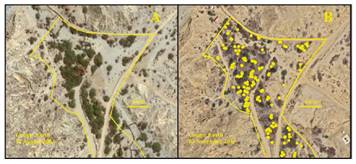
Figure 5 Vegetation cover change between (A) 2003 and (B) 2019 at Cerro Blanco, with yellow dots indicating georeferenced P. pallida stumps in image B.
Considering both the impact of the dieback and logging of P. pallida it is evident that such sites are on an inevitable course to a state of degradation that will render them unsuitable as habitat for the Peruvian Plantcutter.
Results from Quebrada Monte further underline aspects of habitat degradation. Table 3 gives the inventories at both sites QM 1 and QM 2, includes the P. pallida stump count, but percentage proportions are not given.
With QM 1 only 4 plant species were recorded of which T. aphylla was the most common species (48%). Of the 13 P. pallida recorded, 8 were classed as Poor and 1 as Dead on the health-scale, with 2 each in Good and Medium. The B. avicennifolia and C. pyriformis were Good in health. Using Google Earth historical images, the landscape changes within and around QM 1 are evident, Fig. 6.
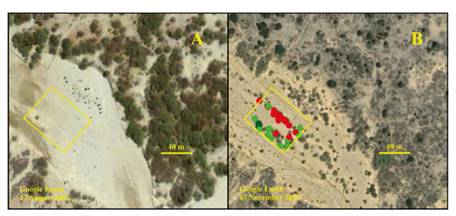
Figure. 6 Quebrada Monte with sample site QM 1 (yellow rectangle) in 2003 (A) and 2019 (B). In B red dots are T. aphylla, light green P. pallida and dark green B. avicennifolia.
Outside the dry gully the deforestation is more than clear between 2003 and 2019. Within the sample area the proliferation of T. aphylla is evident and although P. pallida has also grown, the inventory showed the species to be impacted by the dieback.
Results from QM 2 further confirm the on-going process of degradation. Of a total of 91 data points here, 72 were P. pallida stumps and 3 were standing dead P. pallida. The only resilient species was B. avicenniifolia with 15 individuals in reasonable health (Fig. 7).
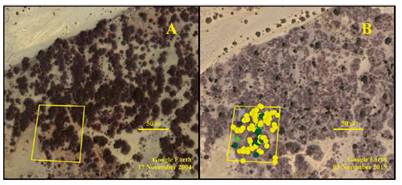
Figure 7 Quebrada Monte with sample site QM 2 (yellow rectangle) in 2004 (A) and 2019 (B). In B yellow dots are P. pallida stumps, light green P. pallida and dark green B. avicennifolia.
These results show that the Peruvian Plantcutter now faces the stark reality of decreasing areas of suitable habitat. With time regular monitoring of sites will further clarify this situation. However, the tendency appears to be loss of floral diversity and ecosystem functionality at a local scale, leading to landscapes where only resilient species will survive, such as B. avicennifolia. Such areas will be unsuitable for the Peruvian Plantcutter.
Discussion
Although the study was conducted over a relatively small area, what is happening at Cerro Blanco in terms of degradation is indicative of the loss of Plantcutter habitat throughout its range. Remaining sites merit urgent protection and restoration to secure the small and now highly fragmented populations of Plantcutters. While Romo et al. (2015) highlighted the threats of habitat degradation, P. pallida deforestation, Tamarix sp. and others, results presented here are the first to quantify the dimensions of habitat loss. Such dramatic levels of P. pallida in poor condition and the near complete extirpation of P. pallida across sites contradicts BirdLife International´s recent downgrading of the species from Endangered (EN) to Vulnerable (VU) (BirdLife International 2020). Selective logging has become increasingly mechanized and efficient over the last few years, with the use of chainsaws and motorized 3-wheeled pick-ups has replaced the customary axe and mule-driven cart. Urgent action is required to address these problems, hence the necessity of publishing these initial findings and their broader context. Historical images of forest cover in Google Earth should be used for future studies and could provide important information on the wider treads in forest cover in the species range. Conservation initiatives need to be based on local knowledge and resident expertise and build on actions already underway.
Over 20 years the author, resident in the nearby city of Sullana, has witnessed the decline of the species´ habitat in the area and across its range. Over the past five years this work has been consolidated under the SOS Peruvian Plantcutter project of Asociación Vida Digna. For the last four years the author has also been assisting EcoSwell, a not-for-profit social and environmental organization in Lobitos, on projects based on the conservation of the Plantcutter in the area. This has led to the EcoSwell project 'Green Lobitos', of which this study forms a part. The above is mentioned to give some context as to on-going activities, including fieldwork, native plant nurseries, reforestation and environmental education, aimed at conserving and restoring the Plantcutter’s habitat in Talara Province.
Talara Province is a critical area for the Peruvian Plantcutter (Flanagan 2018); with records dating back to the early 1900s (Flanagan et al. 2009). That reasonable habitat still exists is probably due to two main reasons: first, large areas of the province are divided into oil concessions held by various petroleum companies, which largely prohibit other activities and second, Talara does not have a regular or voluminous water supply and water has to be pumped through c. 50 km of pipeline from a treatment plant on the Chira river to the south. As a result, the province has escaped agricultural development, especially the agricultural export boom of recent years which has converted thousands of hectares of native vegetation in the Piura, Lambayeque and La Libertad regions to large-scale agriculture. In the early 2000s the proposed US$ 80 million 'Proyecto Pariñas' irrigation project aimed to convert 50,800 ha of land in Talara (overlapping with Plantcutter habitat) to agro-export agriculture. The proposal eventually collapsed amid dubious management and other factors, however the concept of new irrigation infrastructure for large-scale agriculture in Talara Province is still being proposed to this day.
In addition to the deforestation and P. pallida dieback, aggravating an already precarious situation, is the proliferation of the invasive alien species (IAS) Tamarix aphylla (Tamarisk or Saltcedar), which "can have the following effects on ecological systems: dry up viable water sources; increase surface soil salinity; modification of hydrology; decrease native biodiversity of plants, invertebrates, birds, fish and reptiles; and increase fire risk" (Global Invasive Species Database 2020).
This IAS is filling dry riverbeds, water-holes and other areas in Talara Province and displacing the native vegetation. Quebrada Pariñas, north of Talara city, is a normally dry river course more than 30km in length which has become choked by T. aphylla. A study by Liu (2019) near the village of Piedritas, on the south bank of Quebrada Pariñas, used satellite images and groundtruthing to evaluate land cover change over a 15-year period up to 2018. The study showed a 182% increase in vegetation cover over this time period (from 273 ha to 772 ha), however this was mainly due to the spread of T. aphylla within the area. Also, of note over recent years is the appearance of the exotic Vachellia nilotica (Gum Arabic tree), which has been used for hedges, but is now spreading to other areas.
While El Niño-Southern Oscillation (ENSO) events are offhandedly considered beneficial for coastal dry forest regeneration, the author disagrees with this simplistic view. While some replenishment of ground waters is presumed, its significance is questionable due to rapid run-off. A further highly negative impact of torrential rains is the explosive proliferation of Luffa operculata (Jabonillo) and other vines. This creeper can form thick blankets covering vegetation over huge areas, effectively reducing photosynthesis of the bushes or trees underneath, leading in some cases to their death. It can also be assumed that L. operculata is very efficient in using rain waters, due to its rapid and widespread appearance, and that this would reduce available water to the permanent vegetation of an area. Due to the presence of dried L. operculata at study sites, it is evident the species had impacted the area during the 2017 coastal El Niño and may well have assisted the degradation of such sites by impeding the growth of species important for the Plantcutter.
Deforestation and the P. pallida dieback are decimating the last remaining sites of the Plantcutter and when combined with other factors and threats produce a unique situation not faced by any other threatened bird species in Peru. To date no publication has reported on this critical, and largely irreversible, situation. The range of issues facing the Plantcutter imply that any interventions will have to be carefully designed and to this end the author and co-workers are reassessing their procedures as to reforestation. Native plant nurseries of these workers now produce the range of species necessary for the Plantcutter, and small-scale reforestation is underway. Moreover, the most appropriate sites for invention are currently being short-listed, with reforesting planned for 2021.
Nationally, Peru must urgently address the on-going loss of a specific ecosystem and its related biodiversity. Central government should support on-going initiatives at the local level and this must include assisting farming communities (comunidades campesinas) and full legal protection for private conservation areas, amongst other actions. The conservation of the Peruvian Plantcutter and its unique habitat will ultimately depend on the Peruvian state and people and not on the academic musings of people in distant lands.












 uBio
uBio 

